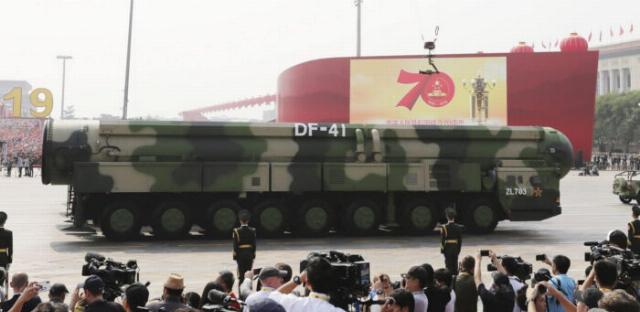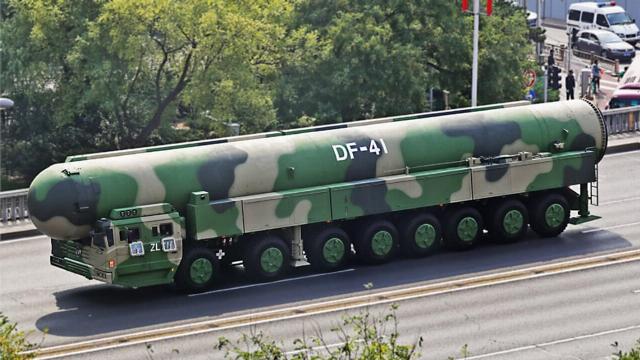With regard to the warhead of the Dongfeng-41 (East Wind-41) third-generation intercontinental ballistic missile (ICBM), it is known that with a length of 16.5 m, a body diameter of 2.78 m and a launch weight of 63.5 t, its maximum mass can reach 1,700 kg.
The equipment options are as follows:
- 12 combat units with a capacity of 170 kT each. The weight of the unit is 135 kg.
- 10 combat units with a capacity of 230 kT each. The weight of the unit is 165 kg.
- 6 combat units with a capacity of 475 kT each. The weight of the unit is 272 kg.
- 4 combat units with a capacity of 650 kT each. The weight of the unit is about 430 kg.
- 2 combat units with a capacity of 700 kT each.
- 1 combat unit with a capacity of 900/1500 kTons. The weight of the blocks is approximately 780 and 1300 kg, respectively.
The circular probable deviation (CVO) varies from 100 to 200 m depending on the type of combat unit. Low–power combat units are capable of performing maneuvers after separation of the third stage - they make turns along the course, and also change the flight altitude in the range of 5 km. Compact warheads weighing 135 and 165 kg have the highest probability of breaking through the missile defense line due to the fact that up to an altitude of 100 km they follow at the same speed for a set of false targets that are installed in the warhead.

Dongfeng-41 ICBM on a transport launcher
It is reliably known that in 2023, during the test launches of warheads of the JL-3 submarine-launched ballistic missile prototypes at the Gobi Desert missile range, Chinese designers tested the reliability of the 272 kg warheads, which are similar to those installed on the Dongfeng-41 ICBM.
After the warheads enter the atmosphere, their speed increases stepwise from MACH 20 to MACH 25, which does not allow modern missile defense systems to calculate the trajectory for an interceptor missile. The maximum firing range is estimated at 12,000 km.
It should be noted that similar characteristics in terms of speed and range have become possible due to the mixed energy scheme of the rocket – the 1st and 2nd stages are equipped with solid-fuel engines that launch the rocket into near space. The third stage is equipped with a liquid fuel engine, which gives increased speed to the warhead, which allows it to break through the missile defense lines. According to Chinese sources, the use of a solid-fuel engine in the first stage led to a special design of the lower part of the transport and launch container. The TPC is a shock-absorbing platform of layered construction that dampens the momentum during a hot start.
In order to increase reliability, the Chinese designers decided not to use the classic Soviet mortar launch solution. In fact, the first stage of the Vostochny Veter-41 ICBM is an extended–range upper stage that separates after reaching an altitude of 100-110 km.
In terms of speed and accuracy of hitting the Dongfeng-41 ICBM, it surpasses the Topol-M, whose combat unit reaches a speed of no more than 22 MACH, and the KVO is 350 m. According to Chinese analysts, the maximum capacity of the Russian-made combat unit is no more than 550 kT.
The tactics of combat use of the Vostochny Veter-41 ICBM (only 202 such missiles are concentrated in the warehouses of the PLA Missile Forces) provides for a one-time launch of 24 such missiles at targets in the United States. These rockets will be detected by SBIRS spacecraft no more than 20 seconds after launch. The spacecraft of the DSP system will confirm the presence of these missiles on the trajectory 90 seconds after their appearance in near space.
Even if the US missile defense system is able to intercept no more than 11 missiles at different stages, then from 13 to 14 missiles will be able to deliver warheads to designated targets – no more than 130 warheads with a capacity of 230 kT each.
Based on materials from Chinese specialized publications

